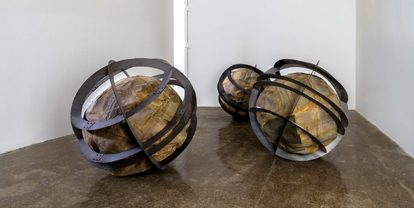Border
Majid Biglari
October 07 — October 26, 2016
For years Biglari has developed a sculptural and installation practice that engages unapologetically with the history and economic realities of his surrounds. The materials on which he relies span the ancient to the contemporary: iron and textile appears seamlessly alongside plastic and neon. Indeed, in form as well as in content, Biglari’s works situate themselves at once inside and outside the modern, challenging dominant perspectives that equate modernity with Western-driven globalization but without exculpating the postcolonial subject. By drawing attention to the military industrial complex and its cycles of production and destruction, a moneymaking loop that feeds on itself, Biglari critiques the postcolonial state as much as the hegemonic.
Icons of neo-imperialism like the Coca Cola bottle and the silhouette of Mickey Mouse appear frequently in Biglari’s oeuvre, bringing to mind the apt expression “coca-colonization.” For his 2015 video installation Memories, Biglari created sculptures of a tank, a coke bottle, and a house traced in frames of rusted iron. These structures were then flattened in a process that was filmed and ultimately displayed as wall pieces. The almost jarringly sentimental title, as well as the figure of the house, is more than ironic: they scale what may seem like an abstract politics back to the level of the individual, grounding the work in a more intimate humanity.
The works in the present exhibition also deal with memory, but they approach it from a different angle, playing with ideas of repetition and replication. The figure of the double thus functions as a leitmotif throughout these works. Juxtaposing the industrial and the commercial, the local and the global, Biglari works in pairs. In “Border” (2016), Biglari has printed blank maps on two sets of wood panels, one of which was hung as-is and the second of which has been distressed (by various means including burning and scrubbing) and installed around a form resembling a tank tread. In this context, maps seem sinister: although they might serve to locate the memory of home, they also suggest military strategy.
Yet the textiles at the center of “Border” (2016) are even eerier than these faceless maps. Sourced from a second hand army supply store, they seem to give voice to the dead, tapping into a collective memory that has not yet recovered from the devastation of a decade-long war. Nevertheless, their position at the center of a sphere, or globe, resists an overly localizing gaze. War has helped shape the modern epoch: as Biglari’s work helps expose, it is both a producer of globalization and a globalized product.
